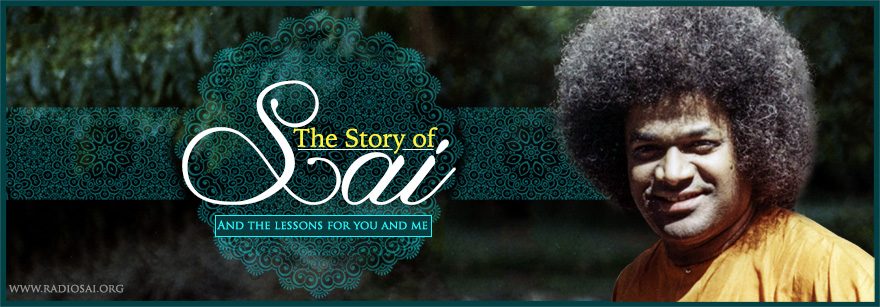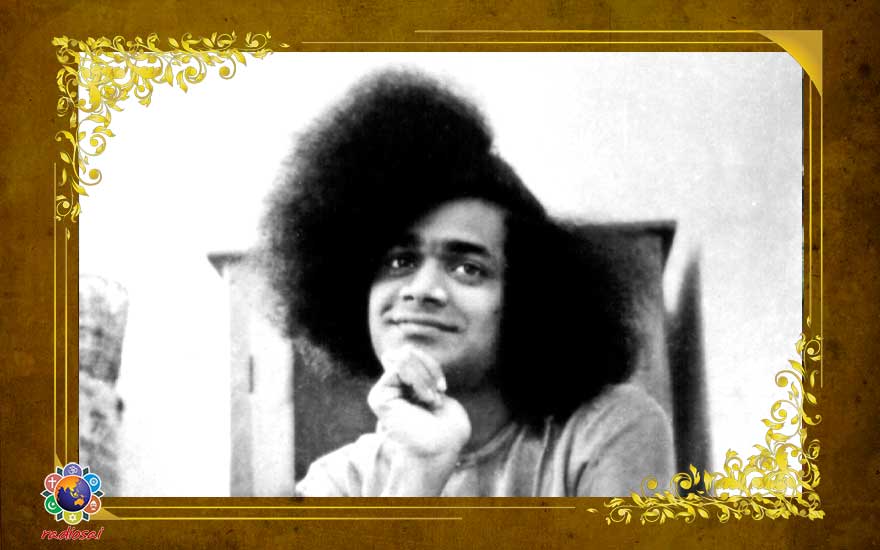|
|
| 'Like' us on Facebook | Follow us: |
Posted on: May 31, 2017
The Story of Sai – 7
And the lessons for you and me
Part 1 || Part 2 || Part 3 || Part 4 || Part 05 || Part 06 || Part 08
 |
The antiquity of The Ramayana, The Mahabharata, and The Bhagavatha is unquestionable and indecipherable. Yet in India they are as fresh and alive in people's consciousness as the stories of their own families. Rama, Krishna, Radha, etc. are almost a part of their daily life and living. What makes these legendary tales contemporary in every age? Rama's paintings and sculptures or Krishna's images and carvings, poems on Rama's glory or discussions on Krishna's message, are as passionately done now as they happened in 3 AD or 13 AD or 1300 AD. What makes them defy time and be relevant to every society over ages? Is it the incredible heroics of Rama? Or the delightful and miraculous sport of Krishna? Or the awesome plot of these captivating poetic narrations? While all this is true, what makes these epics eternal is something more fundamental.
 |
|
| 91st Birthday Celebrations Logo - Download |
“The Ramayana and the Mahabharata are like the heart and the head of India, and are as vital to India as the heart and the head are to a human body,” Bhagawan says and goes on to state what makes these epics so vital: “Sathya and dharma are not related to merely one person, one period of time, or one country; they are related to all people, all periods of time, and all countries...” It is because these tales are nothing but beautiful elaborations of Truth and Righteousness, that they have stood the test of time and circumstance. But this essence can be grasped only if these epics are read not as scintillating stories but as reinvigorating treatises on how to lead a life anchored to Truth and Righteousness.
As much as this is true for these ancient epics, it is the same with the current Sai Bhagavatha too. Every scene and character, sequence and incident, twist and turn in the Sai Saga is for the purpose of divinising man through the practice of Truth, Righteousness, Peace and Love. But to assimilate this deeply and internalise it intensely so that it can be translated into real action, the Story of Sai needs to be not just read but meditated upon assiduously. This series, started in November 2016, commemorating Bhagawan's 91st Birthday is an attempt in this direction. We hope this will help us to reflect more profoundly on the Sai Bhagavatha and implement the lessons learnt more powerfully in our day-to-day existence.
His Story
Pedda Venkama Raju was a quiet, God-fearing man. Brought up in a strong religious tradition, he was strict but understanding, pious and simple-hearted. Though ordinary in appearance, he exuded geniality and generosity. He was deeply interested in music and drama, and exhibited exceptional talent in both.
Reflection
The Bible declares “blessed are the humble, for theirs is the Kingdom of Heaven; blessed are the meek, for they shall inherit the earth.” Pedda Venkama Raju's life is a testimony to this statement of Jesus Christ made some 2,000 years ago when the world hailed Him as the 'Son of God'.
Born in April 1885, Ratnakaram Pedda Venkama Raju was the eldest son of Kondama Raju. Almost saint-like in his persona, he loved to act and sing in plays that described the glory of the Almighty.
 |
However, when the same Almighty appeared as a reality in his home, the complexity that he was surrounded with every day was too much for his childlike heart to comprehend. He was in a continuous state of bewilderment.
Perhaps to put an end to his pitiable plight at the earliest, Sathya made His declaration first to him saying - “I am not your Sathya...I am Sai! My devotees are calling Me”.
It was the Lord's infinite empathy and love for this blessed soul that He chose to not only be born in his clan but also to introduce Himself to the world through him.
But once Pedda Venkama Raju had his doubts cleared, he spent every ounce of his energy and every second of his life serving only Bhagawan whom he too addressed as “Swami”.
He travelled regularly to neighbouring towns of Puttaparthi to procure materials and essential commodities that would make the stay of pilgrims in Prasanthi Nilayam a little less inconvenient.
Everyone who stepped into Puttaparthi was his family and he took care of their needs selflessly.
At the ripe age of 78, when a short and sudden illness took him away from the earth in November 1963, it was no wonder that Swami communicated the following with all His devotees through the Sanathana Sarathi:
“The day he became the father of this Manifestation, that very day he became blessed, his life was rendered holy and sanctified. Remember, this fortune comes only to one individual in an entire age. It is beyond the reach of all.”
Pedda Venkama Raju indeed gloriously marched into the Kingdom of Heaven and inherited the earth like few have ever done in the history of mankind.
His Story
After Pedda Venkama Raju and Mother Easwaramma were blessed with a son and two daughters – Seshama Raju, Venkamma and Parvathamma – Easwaramma suffered four miscarriages. The family attributed this to evil planetary influences and consequently performed rituals to 'pacify' the planets.
Longing for another son, Easwaramma prayed to the village Gods and conducted the propitious Sathyanarayana worship. She kept a number of vows requiring vigil and fasting. It was about time for Venkavadhuta's prophecies to be fulfilled. Thus was born Sathya Sai as the eighth child of Mother Easwaramma.
Not a day passed without something astounding and miraculous happening after the baby's birth. Once, as the new born lay on a bed of piled clothes, the family noticed that He was being raised and lowered by something below Him. Everyone was stunned and, more importantly, deeply anxious.
Upon investigation, they found a cobra coiled among the clothes. Though it is among the most venomous reptiles on earth, the cobra bore no ill intent towards the infant. It was in fact serene, absolutely submissive and graceful.
In another instance, the non-vegetarian meal prepared for the relatives and friends in the Raju household turned into vegetarian food to the astonishment of all.
Venkamma, the eldest daughter of Easwaramma, years later would recount how she had observed Sathya disappear in a haze of light from His mother's lap and then reappear.
Reflection
Lord Krishna, as Bhagawan has revealed, was a poorna avatar – the Supreme Consciousness manifested in human form and endowed with all cosmic powers. It was the same when Krishna reappeared as Sai Krishna. Prof. Kasturi, Baba's biographer, once defined Swami as the descent of ‘all power, all wisdom, all love, all grace and all glory’. Interestingly, like Krishna, Swami too was the eighth child.
Devaki and Vasudeva were devastated souls having seen the demon Kamsa murder all their previous seven children right before their eyes. Easwaramma and Pedda Venkama Raju too were deeply scarred souls having lost four of their children, one after another successively, even before they were born. Both pairs of parents had endured utmost anguish and were at the lowest ebb of their strength and tenacity; however, despite their despair, both were at the zenith of their prayer and surrender to the Lord.
When the baby was born, Devaki and Vasudeva were wonderstruck with what was happening around them. The prison doors opened automatically. The chains fell off from their bodies instantly. The guards went into deep slumber suddenly.
And as Vasudeva stepped out of the jail to shift the infant to Brindavan, to safeguard the new born from the lashing rain and thunder, from under the waters emerged a mysterious wide-hooded snake and covered the baby like a canopy.
 |
The situation in Pedda Venkama Raju's house was equally enigmatic. Just as the divine serpent arrived on the scene moments after Krishna's birth to provide comfort and care, a similar replay occurred during the incarnation of Sathya Sai when Adi Sesha could not wait to have the darshan of the new Avatar of his Lord.
 |
Also, coinciding with the birth of the Avatar, everything that was inauspicious turned auspicious. Food that had pieces of meat magically changed into food that was satwic.
Actually even before Sathya's birth, musical instruments in the house started playing on their own as if to herald a divine occurrence. The atmosphere resounded in a spirit of celebration with the heavens rejoicing as they did during Krishna’s birth – then it was through rain and showers, now it was through music and divine sounds. Kondama Raju, the grandfather, would indeed hear the child talking to him from the womb.
Both the babies were charming beyond description. When they arrived, they did not cry as normal babies do. Instead they smiled!
Witnessing their cherubic smiles people lost sense of time and space. The little mole on His left cheek, only added to the lustre of Sathya Sai's splendour.
Dr. N Jayalakshmi, a long-time devotee of Bhagawan, once took a picture of Krishna to Mother Easwaramma that was drawn by a famous artist. In the portrait, little Krishna was squatting beside a pot and eating butter in a blissful state.
The moment Mother Easwaramma's eyes fell on the image, she said, “Yes! Sathya's face too shown like this, like the moon. He had the same black curly hair. His muscles were strong and well formed. His brows, however, were slightly different from Krishna's; they met in the centre.”
 |
Pointing next at the jewels that little Krishna was adorned with in that painting, she heaved a sigh, “What to do, we were poor. We could not decorate Him so beautifully with so many gems and gold like this child wears.”
The signs and wonders associated with every incarnation of the Lord are as obvious as daylight. Still, man doubts, flounders on his faith and misses the chance of a million lifetimes to seize the opportunity and seek salvation.
The divine hide-and-seek sport of the Lord continues even now within our hearts. Those who recognise it, relish in that joy in their lives. Those who dismiss it, relinquish all joy from their lives.
Part 1 || Part 2 || Part 3 || Part 4 || Part 05 || Part 06 || Part 08
- Bishu Prusty
Radio Sai Team
| comments powered by Disqus |






